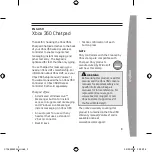
6
Nickel – 4 Linemen, 2 Linebackers, and 5 Defensive Backs. Now you’re leaning a bit more toward the pass,
with speedier players less adept at run-stopping but better prepared to guard against a throw.
Dime – 4 Linemen, 1 Linebackers, and 6 Defensive Backs. This defense is geared toward the pass, and is
best used in long yardage situations.
Prevent – 3 Linemen, 1 Linebacker, and 7 Defensive Backs. The Prevent defense is generally reserved for
extremely long yardage situations, as it essentially concedes the short gain to keep the other team from
breaking off a huge play.
Note:
Some teams may have slightly different initial defensive packages such as the 3-4, the 46, or the
Bear. Take your favorite team into Practice mode to see what their defensive scheme includes.
#2 – Fronts
Once you’ve selected who will be out on in the field, it’s time to figure out what they’ll be doing, beginning
with the defensive line. Scroll through the various fronts to see your options. Think the other team will be
running it up the middle? Try “All In”, which brings all the linemen in and clogs up the middle. Want one of
your linebackers to blitz? Use “Fan” to open up the line a little bit and give him some space to get through.
There are several more available. It’s up to you to decide what to do based on the situation.
#3 – Coverages
Now that the linemen have jobs, it’s time to decide what everyone else will be doing. There are four basic
assignments you’ll see given to the linebackers and defensive backs, which are as follows:
Bump ‘n’ Run – Designated in the play diagram by a T or upside-down T. The defender will play close to the
receiver coming off the line and give him a little bump to try and throw off his timing.
Man – Designated in the play diagram by a short line. The defender will stick with his man regardless of
where he goes. Man coverages give your defense a little more freedom to be aggressive, but make sure
your backs are talented enough to cover their man one-on-one.
Zone – Designated in the play diagram by an orange circle. The defender will stay in his general zone rather
than stick with a specific man. Zone coverages are a bit safer than man coverages, as you’ve typically got
someone else to pick up the slack if one man gets beat.
Blitz – Designated in the play diagram by a longer line extending through the line of scrimmage. Blitz a
player or two if you really want to be aggressive and try to pressure the QB into making a bad decision. But
once again, be careful, because if he doesn’t get to the QB fast enough, the blitzer will be leaving either his
man or his zone potentially more open or vulnerable.
Choose wisely. Learn which types of plays are best suited for which types of situations. Figure out when it
pays to be aggressive and when it’s a good idea to play it safe. The better you know your defense, the better
chance you’ll have of shutting down the other team when it counts most.
Offense, Pre-Snap:
1.
Choose a pass play, and wait until QB is under the Center.
2.
Nudge the
Right Thumbstick
in any of 8 directions:
• Up is a Fly Route
• Down is a Screen Route
• Left/Right are In or Out Route*
• Up + Left/Right
is either a Post or Corner Route*
• Down + Left/Right
is either a Fade or Slant route*
• You can also click the
Right Thumbstick
to have a player stay back and block
3.
Now press the button of the receiver to which you want to assign the chosen route.
4.
After selecting a receiver, you should hear the QB bark out an audible.
5.
The chosen receiver will now run the modified route (or stay back and block).
* Depends on what side of the field the receiver is on.
Advanced Line Moves:
1.
In the Pause Menu, select Options and ensure that Advanced Line Moves are set to ON.
2.
Get on Defense, and before the snap select a Defensive Lineman.







































